Disaster Nursery: After storms, ship groundings, anchor drops and other disasters, there is often a significant amount of damaged coral and no practical way to re-attach them. In these cases, concerned divers can create a short-term disaster nursery to preserve the coral genetics impacted by the disaster. These nurseries must be able to keep the coral alive long enough to build and deploy the chosen artificial substrate and to activate a Coral Team. A Disaster Nursery is designed hold coral up to a maximum of about one year.
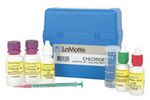
Dissolved Oxygen (DO) Test Kit: There are many inexpensive and effective DO test kits on the market. We have found that the Lamotte kit is easy to use, accurate enough, and priced under US$50. Be sure to follow the instructions carefully to get an accurate measurement. Testing DO at the site of the coral table is critical when first setting the table up and on particularly hot or stagnant days, or days following a heavy rainfall. If testing indicates that DO levels are over 4.5 mg/l, it is safe to conduct coral fragmenting and coral table operations.
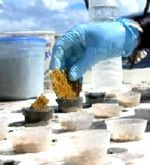
Dry hand dipper and placer: The person at the coral propagation table who handles dry fragmented coral; receiving the frags from the wet hands helper, dipping them into RBF antiseptic, shaking off any water on the fragments (water or antiseptic will prevent the frags from setting into the cement properly), and then placing them in the correct orientation in the wet cement in medicine cup molds. Some high-speed tables operate with 2 dry hand dippers and placers.
Epoxy Putty (aka RBF Coral Underwater Epoxy): A two part epoxy stick with a specific viscosity that allows for easy underwater mixing, yet stiff enough to hold coral plug in place until it hardens. RBF branded coral epoxy putty comes in a 9-minute (green and white) and a 5-minute working formulation.(brown and white) The 5-minute version is better for larger fragments that are prone to dislodging during wave surges, but requires more frequent mixing and is therefore less efficient and prone to waste. The 9-minute formulation is normally used for most situations. If you choose a non-RBF brand, be sure to test that they are not toxic to coral. (Do not use Devcon branded epoxy for that reason, and generally any strong smelling brands are not suitable.). If the brand you choose is too thick, it will be very time consuming and difficult to mix underwater. If it is too thin, it will not hold the plugs in place. If it is too sticky, it will be difficult to remove from your hands. If it is not sticky enough, it will not bond well. Expect some staining of your dive suit and dive gear whatever brand you choose… we consider it the mark of a veteran coral planter! EPVS value (Effective Protective Void Space Value): EPVS is hypothetical measurement used to estimate how much foray space a particular reef object is providing for a particular species or functional group of organisms. It is sometimes further defined by the type of foray activities so that a single species may have multiple EPVS values. For example food foraging foray may be different than resting or mating foray. EPVS calculations can be used to compare rehabilitation methods to help predict success for particular species. A group of indicator species weighted by relative populations can be used to compare rehabilitation methods protective void space creation directly.
Essential Fish Habitat (EFH): Congress defined essential fish habitat as "those waters and substrate necessary to fish for spawning, breeding, feeding, or growth to maturity." (Federal Register 2002). Basically, this refers to critical geographical areas used by a species for any of the above purposes, an example would be areas of the Florida Keys used for spawning each year by Nassau grouper (Epinephelus striatus).
Fouling Community: A general term used to describe the assemblage of marine invertebrates, algae, and other marine life that is attached or lives directly on hard substrates. When a new artificial substrate is deployed, this community will develop over time in somewhat predictable patterns until it reaches its mature state. Typically, diatoms are the first colonizers followed by turf algae. After this, the succession of fouling community depends on the climate but usually includes tunicates and hydroids and some molluscs such as barnacles or scallops. In 3-6 months, with good water quality, coralline algae will form red, pink or purple patches that lay the groundwork for good natural coral settlement. These will be especially prominent when long spiny sea urchins (Diadema spp.) or other herbivores are present in good numbers. Without any coral plantings, properly built Reef Balls in the appropriate water quality will naturally develop into a coral reef in 8-25 years. Planting coral can speed this process up significantly.
Fire Coral: Fire coral (Millepora spp.) are sometimes desirable to propagate due to the types of fish that use them for protection. Typically, Reef Balls are planted with a monoculture of fire coral, since it will outcompete most other species, and only a few plugs are required because most fire coral species grow and spread very fast. In a calm area, just laying a few fire coral fragments on a Reef Ball may be enough to get them started even without plugging.

Fire Coral Mitt: Fire coral can cause a painful rash when handled with bare hands. Latex gloves can easily tear when handling coral, so when working with fire corals, especially when hand fragmenting, RBF team members will use a silicon oven mitt for protection. Flashing: Flashing, or flash, is used to refer to the moment the Plug Cement "skins over", usually between 20-60 seconds after pouring the cement. At this moment, no new coral fragments can be added and it is time to initiate plug curing. Anyone at the coral propagation table can call the word "Flashing" when it is observed, in order to signal the dry hand dipper and planter to pass the flashed plugs to the wet hand coral handler for placement in the coral curing and planting tray in the water below the coral propagation table. After placement, the wet hand coral handler records the time so that the plugs can be moved to the popping station after 20 minutes.
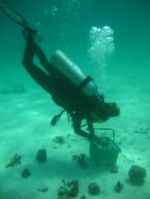
Fragging Nursery: An temporary underwater area used to hold imperiled corals until they can be further processed into fragments. Water temperature and water quality in the nursery must be the same as the original source of the coral. A sandy bottom away from the reef is preferred because work will be done underwater that could disturb the bottom. The fragging nursery is often located between the source of coral and coral propagation table.
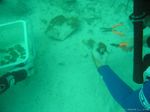
Fragging: The art of separating individual coral colonies into small fragments suitable for plugging and planting onto substrate. This skill takes a great deal of practice, because each coral species has different tools and techniques required to achieve a viable fragment.
Fragment: A subset (small piece) of a larger coral colony that has been separated from the larger colony by mechanical means. A fragment contains the same genetics as the parent colony. If two fragments from the same colony are planted close together, they will re-fuse into a single colony. If two fragments from different parental colonies are planted close together, they will not fuse and instead will compete for space. This is true even within the same species. The only exception is when two different parental colonies that share the same genetics (i.e. they were originally part of the same colony or both were originally fragmented from the same parental colony) in which case they will still fuse together.
Fragmentor: The person who works below the surface, using SCUBA gear, to fragment imperiled coral to prepare them for the wet hand coral handler.
Genetic Coral Rescue: A coral rescue method where a few small fragments are taken from each coral head that was damaged and are replanted to create new genetically identical colonies.
GIS: Acronym for Geographical Information Systems. GIS software can be used in conjunction with GPS data to generate detailed maps, and access accurate spatial databases of information for an area.
GPS Receiver: A hand-held or boat mounted unit designed to receive data from Global Positioning System satellites and calculate the unit's exact position on Earth's surface. These units can be accurate to within a few meters, and can be used to generate extremely accurate maps of project sites.
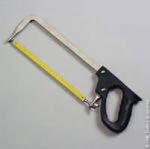
Hacksaw: Sometimes compression tools like bone cutters are unable to fragment a larger coral. In these cases and a hacksaw can be used. A hacksaw can also be used to make a scar line to aid compression cutting of a coral fragment.
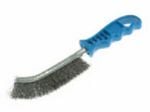
Hand Brush: A wire hand brush is used to clean the area adjacent to the coral plug hole before planting on an artificial reef module that has been deployed for more than a few days. This provides space for the coral to base and attach itself to the artificial substrate.
Handling Style Groups: Reef Ball Coral Teams group corals into general groups when they share common propagation techniques or are restabilized in similar ways. For example, finger size branching corals are usually divided by a wire cutters and they usually exhibit good basing qualities. Following are a stand set of Handling Style Groups:
- Fire/Lace corals,
- Soft corals with woody stems (excludes sea fans)
- Sea fans
- Soft corals without woody stems
- Finger sized branching corals
- Large diameter branching /pillar corals
- Encrusting corals
- Mound/boulder/brain corals
- Leaf/plate/sheet corals
- Flower/cup/single polyp corals
- Black corals
- Other
Note: Specific Coral Teams may need to add additional groups based on local coral handling needs. As a training goal, volunteers on a coral team should at least be able to identify most corals as belonging to one of these handling style groups.
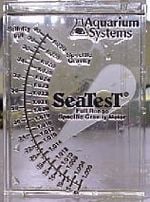
Hydrometer or Specific Gravity Meter: A hydrometer is an inexpensive way to approximate salinity that can be found at most aquarium or pet stores. It can be used to check the salinity of the Antiseptic dip if you are not using veterinary strength solutions. It can also be useful if you are working where freshwater runoff can affect the conditions at your nurseries or coral propagation table.
Hydrostatic Method: A traditional technique using hydrostatic cement to attach adult coral, live rock, or other marine life directly to the chosen base substrate or artificial reef without plugging. To be effective, the team member must be able to make a mechanical bond on both the substrate and the object being planted. This method involves mixing hydrostatic cement in a plastic bag on the ocean surface and sending it down for a diver to work it into a putty-like consistency, which is then used to re-stabilize mature or large coral colonies. This method takes special training and practice to be able to perform reliably. Too much water in the mix can greatly weaken the bond. RBF has seen better results when adding 10% by volume of microsilica to the hydrostatic cement mixture, but care must be taken that the dry microsilica and dry cement are mixed together well as they tend to separate. The Degussa company makes an admixture called "RHEOMAC UW 450" that can be added to the hydrostatic cement to keep it from causing an underwater cement plume when it is removed from the mixing bag. With Rheomac UW450, the water also remains clear where you place the cement, making it easier to work at the coral's base without damaging the coral. This method is time consuming, and the materials are expensive, therefore it should be used with discretion.
Imperiled Coral: A coral colony that without assistance will most likely die within one year. Examples include:
- 1 Loose or broken coral fragments or colonies disturbed by storms, ship groundings, anchor drops, etc. that have landed on non-hard bottom types, where it is expected that they cannot stabilize themselves to prevent sinking into the soft substrate or constant overturning and dying.
- 2 Coral that will be directly killed in the near future by dredging, marine construction, or other human activities.
Juvenile Fish Nursery: Most marine fish are pelagic spawners and in the larval stages the fish are widely dispersed. Studies have indicated that survival rate in the late larval to early juvenile size range as these larval fish attempt to find shelter and food on the reef, is a key factor in the rate of fish production. Small, low-height, complex or widely scattered structures are ideal for protecting fish at this stage. Red mangrove roots, sea grass beds, and scattered patch reefs are good examples of juvenile fish nursery areas. Artificial reefs can be designed to mimic this function too.
Light Intensity: There are many different units to express the amount of light over an area, some common ones include Lux, Micro Einsteins, Foot Candles, and Lumens. Sometimes, light metering devices are used to make sure coral are not exposed to rapid changes in lighting levels that are beyond their ability to adapt. Knowing what levels of light are acceptable requires species-specific knowledge, but in general, and especially when transplanting, it is best to keep a species as close to the ambient light conditions where it was originally found.
Map Datum: Geographical Positioning Systems (GPS) use a specific "map datum" to locally reference the GPS receiver to the satellites. If you do not specify the same map datum for the coordinates you are given you may not end up at the same location. So be sure to set your equipment to the proper map datum specification. Unless otherwise specified, the map datum should be defined using "WGS 84", a default datum that is most frequently used to define coordinates in GPS units.
'Mass Spawn: Many species of coral synchronize their spawning times so that all colonies of the same species spawn at the same time. When this event occurs it is called a mass spawn. Within a few months is the best time to deploy artificial substrate, in order to maximize natural recruitment, because corals have a better chance of successfully colonizing fresh substrate than substrate already colonized by fouling organisms and coral predators.
Mechanical Bond: When using the direct putty method or hydrostatic cement method, a mechanical bond is formed when both surfaces have an undercut, which creates an overhanging portion at the interface between the two surfaces. Mechanical bonds are much stronger than adhesion-only bonds. Note: The rough surface texture created on concrete by using sugar water as a surface texture enhancer and then rinsing with water after de-molding creates an excellent undercut surface for mechanical bonds.
Microsilica: A concrete admixture added to reduce the permeability of concrete, neutralize the pH, and double the concrete strength. It is dosed at about 5%-10% of the total amount of Type II Portland cement used or 15% of the hydrostatic cement volume. Higher dosage rates provide an exponentially diminishing return with no increases in performance beyond a 30% Microsilica/Portland ratio.
Mixer: The person at the coral table who mixes and pours the cement. Typically the Table Boss. See: Table Boss
Mixing: In RBF terminology, this refers to the phrase shouted at the coral table by the table boss at the moment the plug concrete mixing is initiated. At this point, the wet hand fragment handler readies the coral fragments for passing to the dry hand dipper and placer.

Monitoring Frame: A PVC camera guide with a fixed optical length and a rectangular measuring quadrat marked with metric and English scales. Used to position the camera over coral plugs to take standardized monitoring photos. Advanced users will add movable "luggage tags" with numbers or letters to encode variables such as artificial reef module identifier, date or coral colony identifier. Length of the rod which attaches the monitoring frame to the camera will vary with the focal length of the camera used. Focal length should be adjusted in advance with the camera in wide-angle (non-zoomed) format. When taking monitoring photos, make sure camera is in the same position relative to the subject being photographed for each image. Most divers prefer a frame that is neutral or slightly negatively buoyant. Gravel or lead shot can be put inside the frame for this purpose. Frame should have small holes drilled into it to allow water to flow in and out.
Morphology or Coral Morphology: The ability of many coral species to build a colony in various shapes to adapt to local growing conditions. Factors can include lighting, currents, food availability, etc. A coral planted as a fragment can develop its morphology to suit the new location. An adult colony transplanted to a new location does not have this ability. This difference is one of the major reasons survival rates are higher in fragments than for transplants in coral that have this ability. Morphological differences are one reason why identifying coral species can be so tricky, because the same species can look markedly different in various environmental conditions. Natural Recruitment: Base substrate or a properly designed artificial reef will recruit and develop a fouling community over time through the process of natural recruitment. That community will include coral and other desirable marine life, presuming the water quality and site location is suitable. In most cases, even without any effort for coral propagation and planting this will occur over time.
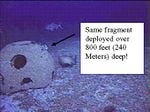
Oculina: A group of hardy coral species, some of which can survive at great ocean depths with very light levels and some of which tolerate very cold temperatures.
Oil Free Sun Block: Coral Team members are required to protect themselves from sunburn. Loss of a team member's function due to sunburn can disrupt typically tight project timelines. However, most sun care products contain oil that can contaminate the coral propagation table. Oil is particularly dangerous because it can form a film on corals, or on water containers used for corals, which can disrupt the flow of oxygen across the surface, and stress the coral. Therefore, Coral Team members are required to use oil free sun blockers (typically in spray formats that make frequent applications easier).
Pancake Syrup: This term is used by RBF Coral Teams to refer to the appropriate consistency for plug cement, approximately that of unbaked batter or maple syrup. Mixing cement to this consistency takes practice and is one of the most important aspects of quality control on the coral propagation table.
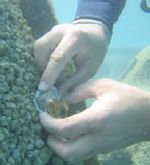
Planting: Affixing the coral plug into the coral plug hole with underwater epoxy putty.
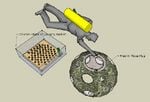
Planting Team: A dive team that mixes underwater epoxy putty and plants coral plugs onto substrate modules. Sometimes divers work in teams of two, with a mixer and a planter and sometimes each member does both tasks. In many cases, planting teams do not wear fins when planting to avoid accidentally knocking off adjacent, freshly planted coral plugs. Even in shallow water, dive tanks should be used to ensure careful slow movements needed to plant coral without disturbing other freshly planted plugs. Team members can use the tray to store supplies such as a wire brush, or extra epoxy putty. Planting teams need to be trained on the project's planting strategy to know where to plant coral plugs with specific coral species. Planting errors can take years to show up and avoiding them can be important for long-term success. A veteran planter in good sea conditions can plant 100 or more coral plugs per hour, but variable conditions such as current, surge, or reduced visibility can reduce this number drastically. An experienced and skilled planter uses much less epoxy putty per coral plug than a newly trained beginning planter. A beginning planter may get 5-7 plugs per epoxy stick, whereas a skilled planter can get 20 or more. When computing the amount of epoxy putty needed for a project, take this variable into account.
Planting Strategy: A planting strategy must be developed to allow the base materials to develop as closely as possible to the species diversity and population densities of nearby natural reef. Mastering the development of planting strategy takes a level of skill that is beyond most volunteer teams. Typically, the Foundation develops a planting strategy using RBF experts, who are assisted by as much local expertise as can be accessed. Todd Barber, John Walch, Lorna Slade, Marsha Pardee and Mario van der Bulck are currently (2006) the RBF experts that have the level of understanding needed to develop good planting strategies. There are probably some coral rehabilitation specialists/scientists that have similar skills, particularly ones that know specific local environments well. We also hope to develop more experts, but this type of training takes years, not months. Some of the complex factors that go into planting strategy are:
- 1 Environmental tolerances of the particular species (lighting, currents, sedimentation, resistance, salinity, temperature changes, feeding requirements, depth limitation, etc.)
- 2 Warfare or fusing of coral colonies
- 3 Expected growth rates of various species
- 4 Expected natural settlement on the artificial reefs
- 5 Water quality, present and expected
- 6 Wave and climate expectations
- 7 Goals of the individual project (for example aesthetics, specific use, etc.)
- 8 Capabilities of the project (how many coral can be planted, etc.)
- 9 Preferences for threatened or endangered species
Plug Cement or RBF Disk & Plug Mix: A mixture of hydrostatic cement, microsilica and optional proprietary ingredients used by RBF coral teams for making coral plugs.
Plug Curing: Placing a freshly plugged coral, still in the medicine cup after flashing, into the sea for 20 minutes or more until the plug is hard enough to separate the coral & plug from the medicine cup and sand.
Plugging: The process of imbedding small coral fragments into a standard medicine cup; which is filled first with 1/2 inch of sand and then filled to the top with 30 second setting plug cement.
Plug Nursery: Sometimes, it is not practical or possible to plant plugs immediately after plug curing. In these cases, a temporary plug nursery can be established, which is a protected area where the coral plugs can be safely stored until it is time to plant them.
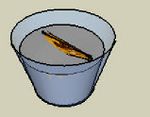
Plug: A coral fragment embedded in a small concrete cup so that it can be easily attached to the artificial reef substrate and to promote a good base formation.
Plug Twine: Some coral species, most notably sea fans, are difficult to epoxy into a coral adapter plug hole because the slightest sea surge causes them to pop out of the hole before the epoxy has a chance to harden. Therefore, a temporary brace is created using cotton string (twine) to hold the plug into the surface of the artificial reef module until the coral epoxy putty hardens. The twine is then removed.
Popping Station: After a coral plug hardens for 20-30 minutes underwater, the coral curing and planting tray is removed from under the table and the Popper will remove the plastic medicine cups from the coral plug by pressing their fingers on the sand filled portion of the medicine cup until the plug "pops" up. This is done using a technique to catch the plug from the side so that there is no need to touch the coral. The "popped" plugs are then re-placed in the tray and turned over to the planting teams. The medicine cups are recovered and returned to the coral propagation table for re-use.
Popper: A Coral Team member trained to remove coral plugs from medicine cup molds without touching the attached coral fragment.
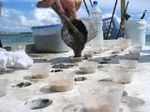
Pouring: A term called out by the Table Boss when the coral plug molds are about to be poured. This signals the dry hand dipper and planter to begin treating the coral with an antiseptic dip and then to ready them for placement into the fast setting plug cement. From the time the Table Boss starts "Pouring" it is typically 30 seconds until the concrete flashes.
Propagation: The act of creating multiple coral colonies from a single colony. This is functionally equivalent to cloning plants.
Propagation and Planting induced Coral Fragment Death: In the first 48 hours transplanting plugs, the major causes of fragment death are Rapid Tissue Necrosis (RTN) or a failed epoxy bond. From 48 hours to 90 days the major cause of plugged fragment death are coral predators. Beyond 90 days, losses are usually related to improper basing or incorrect placement location for the species such as too much or too little light, incorrect depth, too close to sediments or improper orientation to currents. Survival rates of propagated fragments are variable, based on how well the techniques in this manual are practiced. Properly handled propagated fragments can have mortality rates close to those of natural coral in the area, and this is the goal every project should strive to achieve. A monitoring program should be established to determine if this goal is being achieved. When a monitoring program establishes that fragment death rates exceeds the expected rate by more than 10%-20%, procedures need to be reviewed and corrected before additional propagation and planting. If specific techniques can be documented to eliminate part of this mortality, they should be reported to the Reef Ball Foundation for addition to this manual. This is one of the most critical roles of grassroots-based monitoring. Globally, our projects average about 80-90% survival compared to background natural mortality, which is quite good, but there is still room for improvement. Note: Even though there is an expected mortality rate in fragments above that of natural coral, the net number of new colonies is always higher than without propagation efforts. This is because coral are propagated, not transplanted.
Propagation Tears: Many brain coral, lettuce coral and encrusting soft coral species develop tear-shaped lobes as they naturally try to propagate themselves. These "natural" fragmenting lines can be used to create fragments on coral that typically cannot be fragmented easily.